Farms predicted to cop average $69K loss this season
The crippling drought is predicted to cut NSW farm income in half this financial year, giving the average broadacre farmer a massive loss of $69,000.
NSW
Don't miss out on the headlines from NSW. Followed categories will be added to My News.
- The Telegraph says: Our farms desperately need your help
- NSW drought set to force Sydney water restrictions
- Picture gallery: Devastating reality of drought in NSW
The crippling drought is predicted to cut NSW farm income in half this financial year, giving the average broadacre farmer a massive loss of $69,000.
The devastating dry spell has reduced crop production — pushing up fodder and feed grain prices — while also reducing the availability of pasture on livestock farms.
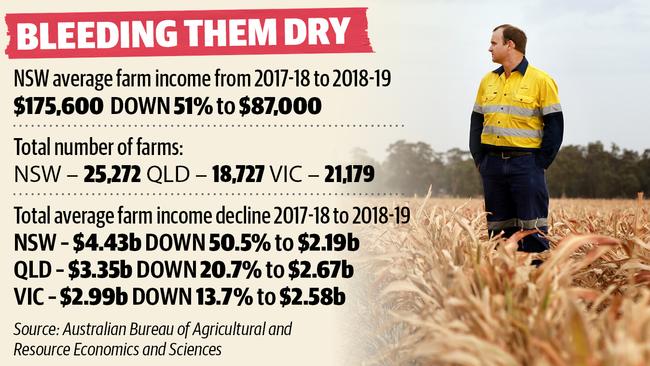
MORE NEWS:
Confessions of an ice addict: ‘I’ll knife you for drugs’
Man caught with hallucinogenic plant in luggage
Nomads bikie figure finds new love, loses Instagram
The Department of Agriculture’s farm business performance figures show that wheat and cropping farmers are expected to be hit the hardest, with livestock industries also predicted to record lower revenues due to the higher feed costs.
SUBSCRIBE TO THE DAILY TELEGRAPH: $12 for 12 weeks
The far west and north western regions of NSW are expected to record the largest decline in income due to severe rainfall deficiencies harming crop production.
The ABARES report shows that in the year to June 2019 the average income for a NSW broadacre farm will be slashed by 51 per cent to just $87,000 — resulting in the huge loss of $69,000.
National Australia Bank agribusiness economist Phin Ziebell said a majority of the 25,272 broadacre farmers in NSW have struggled this year due to the lack of rain.
“A lot of areas had basically no crops last season and they incurred all the costs associated with trying to get it off the ground, so in a season like that you wouldn’t expect to be really profitable,” he told The Daily Telegraph.
“That (income fall) obviously flows through to regional towns because a lot of these towns have farming really at the heart of their income, so if you don’t get income coming through then it will affect every aspect of that economy.”
Mr Ziebell said 2016 had been “an absolute cracker” of a season, meaning many farmers deposited cash into farm management deposits that year, and could now draw down on those funds in tougher times.
NAB has supported The Daily Telegraph’s Adopt a Farmer campaign with a $100,000 donation to the initiative which aims to help thousands of farmers.
Schools across NSW will host a gold coin mufti day on Wednesday to raise funds for Rural Aid to distribute Visa cards with $100 on them to thousands of farmers.
NAB is the largest agribusiness lender in the country with 550 specialist bankers and 30 per cent of the total market share. A recent survey of NAB bankers in regional areas found agribusiness conditions slipped during the fourth quarter of 2018, weighed down by poor profitability, weaker trading conditions and poor cash flow.
“Conditions were weakest in NSW which endured severe drought in large parts of the state and strongest in Western Australia which enjoyed (the) second biggest winter harvest and solid grain prices,” the survey said.
“One in five bankers said weather events had the biggest influence on confidence. Other key factors were the outlook for their business, government polices and regulations, pressure on margins and labour availability.”
The ABARES report figures are a snapshot of the sector and are part of an annual survey program which interviews operators of around 1600 broadacre farms and 300 dairy farms across the country.
HELP YOU CAN BANK ON
As a devastating drought ravages regional NSW bankers and their farm clients are learning from past mistakes to ensure when the rain finally comes they will be able to quickly bounce back.
Where bank managers were once seen only as people sent out to foreclose on farms crippled by debt, a new approach by NAB aims to reinstate bankers as pillars of the local community, who understand and support their rural clients through tough times.
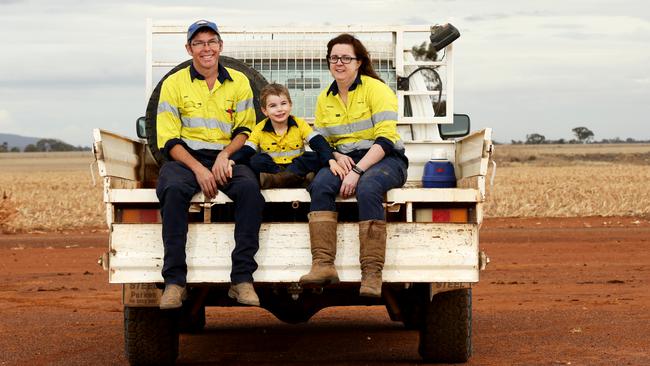
NAB managing partner for central NSW James Nash said farmers and the banks had “learnt a lot” from the devastating millennium drought in the early 2000s.
“The biggest lesson was realising that if you stay patient with clients and you work closely with them, they can quickly recover (from a drought),” he said.
Mr Nash said strong land values provided farmers with equity if they needed to temporarily inject more capital into their business.
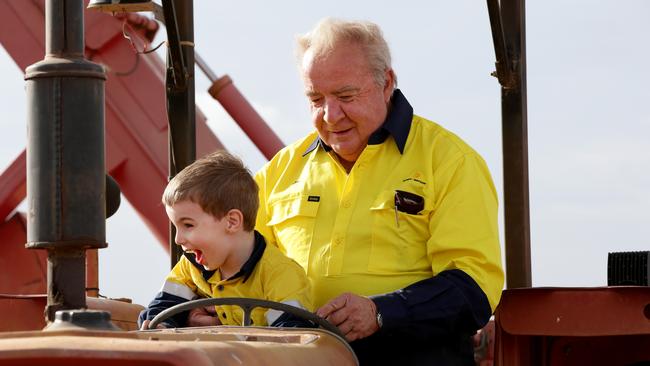
Siblings Bruce Watson and Katrina Swift work with their partners and parents Jim and Janelle Watson to operate about 8500 acres of crop farmland near Forbes in central NSW.
In an area known for wheat, barley and canola, the family has tried to mitigate the risk of a total crop failure by expanding into alternatives such as chickpeas and other legumes.
Katrina’s husband Mark Swift said reduced rainfall, severe frosts and high summer temperatures have wreaked havoc on local crop production.
Mr Watson said the family has been with NAB for more than 20 years and said the bank had been very supportive.
“Communication is paramount,” he said.
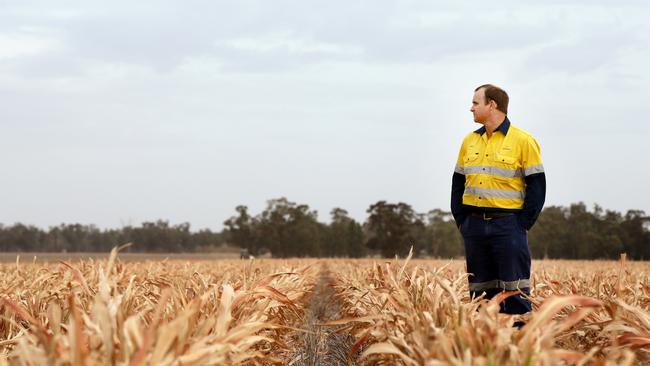
NAB agribusiness manager Liam Skinner said he spends about half the week on the road visiting clients, including the Watsons and Swifts.
“It’s really important to have that understanding of what they’re going through and see what is happening,” he said.
NAB has supported The Daily Telegraph’s Adopt a Farmer campaign.
COMMUNITY SPIRIT SHOWN IN MILK OF HUMAN KINDNESS
It’s been the cornerstone of the community for years and now the local store is stepping up to lend a hand to drought-affected farmers.
Milton IGA has adopted five local dairy farmers and the community has taken them under their wing.
Shane Wilson and Anthony Latta decided to increase their price of milk by 10 cents a litre in September, before the big chains jumped on board.
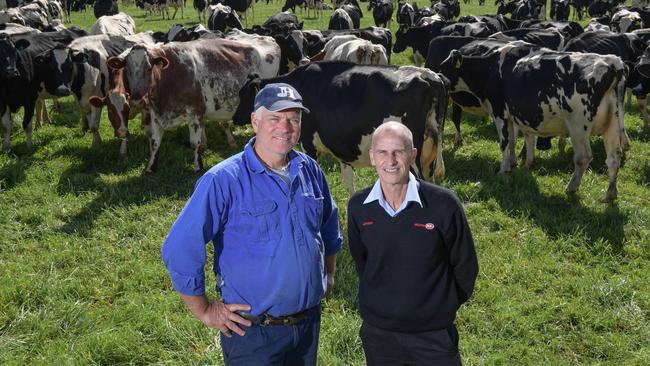
They also threw in 10 cents of their own money for every litre that they sold.
Mr Wilson said they raised $5000 for their local farmers.
“I hated selling milk for $1 a litre, I despised it, but we did to compete with Coles and Woolworths,” he said.
“But we didn’t have one negative comment from a customer because they all knew it was going towards farmers in our community.”
Robert Miller was one of these farmers who has had to send 300 of his 1000 head of cattle to the abattoir because he couldn’t afford to keep them alive.
“To see the community willing to pay more to help us was a morale booster for us farmers,” he said.
“We are still not really covering our costs, the costs of feed is still too great but every cent extra we can get can keep us going.’’
Coles and Woolworths have since followed the little store in Milton’s lead but farmers are still struggling to survive the drought.
“In the year 2000 we were getting 57 cents a litre, then we were getting 50 cents and now with the levies we are getting 55 cents. My costs are $1 a litre,” Mr Miller said.
Mr Latta said farmers needed support.
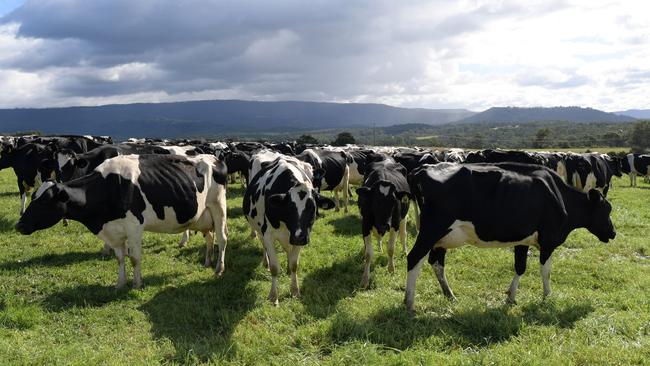
“We have looked after our own farmers because they shop with us but all of NSW is suffering,” he said.
“This drought has had a big impact on everyone and if we want this quality food they produce we have to support them.”
IGA Orange and Dubbo owners Rochelle and Ian Ashcroft said their customers looked to them when they wanted to help farmers.
“Last year when it became a national issue people began coming in to us with food just assuming we would deliver it to farmers,” she said.
“So we organised Aussie Farmers to collect the food each week.
“One time we had a customer of ours come in and asked if we could buy them $500 worth of hay for their animals because they can’t afford it.
“Our staff did it without even asking us and drove the hay in our work van out to their farm.”
She said the charity work had taken on a new corner, with the store donating food for the Feast for Farmers in Orange which raised $40,000.
Originally published as Farms predicted to cop average $69K loss this season


